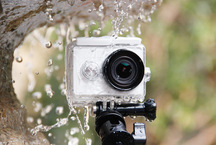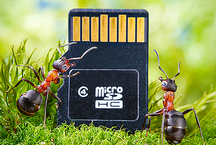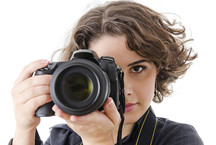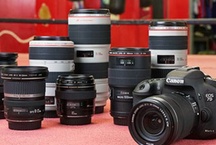12 best canon cameras




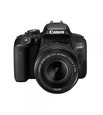
The history of Canon is inextricably linked with photographic equipment: two of its founders began in 1933 with the development of a compact 35-millimeter camera. The funny thing is that the optics for the first commercial sample of the Canon camera were provided by none other than their main competitors in our time - Nikon. And it was Canon's small workshop that eventually became the world leader in the production of photographic equipment, both for the production of the cameras themselves and the interchangeable optics for them: almost every second digital camera sold in the world bears this brand.
It is impossible to achieve such results with just a big name, especially in the professional segment. Well, it is worth looking at the Canon 2019 model line - perhaps it will be some of these models that will soon be in your hands? Review of the best (according to experts and photo amateurs) cameras Canon - in our rating.
Rating best cameras Canon 2018-2019 year
| Category | A place | Name | Rating | Price |
|---|---|---|---|---|
| Best Canon Compact Cameras | 1 | Canon PowerShot G1 X Mark III | 9.9 / 10 | 82 500 |
| 2 | Canon PowerShot G9 X Mark II | 9.8 / 10 | 27 990 | |
| 3 | Canon PowerShot G1 X Mark II | 9.5 / 10 | 44 790 | |
| Best mirrorless Canon with interchangeable optics | 1 | Canon EOS R Kit | 9.9 / 10 | 186 000 |
| 2 | Canon EOS M5 | 9.8 / 10 | 49 990 | |
| Canon's best ultrazoom | 1 | Canon PowerShot SX740 HS | 9.8 / 10 | 28 490 |
| Best Canon Amateur SLR Cameras | 1 | Canon EOS 2000D | 9.4 / 10 | 25 990 |
| The best Canon cameras "advanced amateur" class | 1 | Canon EOS 77D | 9.8 / 10 | 44 990 |
| 2 | Canon EOS 800D Kit | 9.7 / 10 | 49 990 | |
| Canon best semi-professional SLR cameras | 1 | Canon EOS 6D Mark II Body | 9.9 / 10 | 37 138 |
| 2 | Canon EOS 7D Mark II | 9.4 / 10 | 87 694 | |
| Top Canon Professional SLRs | 1 | Canon EOS 1D X Mark II | 10 / 10 | 305 590 |
| 2 | Canon EOS 5D Mark IV | 9.9 / 10 | 171 370 |
Best Canon Compact Cameras
|
We were waiting for this camera: the previous generation was released five years ago, and this is a serious time for cameras, even the professional line of DSLRs is updated more often! And since then, the flagship of the compact series has been well updated, fresher, although it has risen in price, perhaps, to a price that is indecent for a non-system camera - the previous series managed to get into our market at a completely different exchange rate. And, by the way, this Canon did not break the tradition, having again won the TIPA 2018 Best Professional Compact Camera award. The camera, “dressed” in a dust-and-moisture-proof magnesium case, became smaller and lighter than its predecessor - in appearance, which mimics under reflex cameras, this is not to say if there are no other items in the photo for comparison. Therefore, a “live” acquaintance with the Mark III can even be shocking, as compact as it is in reality. At the same time, the camera finally got a built-in OLED viewfinder with a resolution of 2.36 megapixels, which gives one hundred percent image coverage, and the matrix — not “almost APS-C”, but “real APS-C”, grew from 13 to 24 megapixel, yes also happy with the support of Dual Pixel. From here - great autofocus work. The lens with a triple zoom, equipped with an optical stabilizer, has an equivalent focal length of 24-72 mm, and at a “wide angle” it has a good aperture ratio - f / 2.8. So, if necessary, optics can even depict a not very bad side, though only at the minimum focal length. On the whole, in terms of image quality, this Canon camera is quite capable of arguing with the “crooked” mirror counterparts of at least a three-digit series, and this, you see, means a lot for a compact. Another thing is that we will have to pay a lot for compactness - with this money you can buy a “carcass”, no less, EOS 6D Mark II and get good optics for it, and this will be a full-fledged full frame! Main advantages:
Minuses:
|
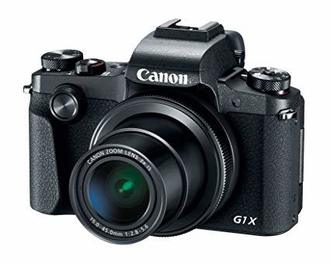 9.9 / 10
Rating
Reviews
The camera is very much to the amateur - you will agree, if the image quality is really important, then for the same amount there is a full frame, not a crop. |
|
27 990
The Powershot G series at one time took a great start: already one of the first cameras, the Powershot G10, won the TIPA award in the Best Expert Compact Camera nomination of 2009, and since then the series has already 5 such awards. So what does the Canon PowerShot G9 X Mark II offer us? Before us is a compact, in the spirit of fashion, diligently depicting an old film camera. He is especially handsome in silver with brown overlays - indeed, if you don’t look from behind, it seems like a real filmmaker. But inside it is an inch 20-megapixel matrix and a fast Digic 7 processor, introduced last year. A high-aperture lens (f2.0 for such lens sizes is an excellent result) has a small range of focal lengths, but this is not surprising: in the end, it was the compact that was created. But retro-styling doesn’t mean retro-functionality either: the G9X Mark II can transfer files and control via WiFi and Bluetooth, it’s easy to interface with mobile devices via NFC. In a simple-looking lens, a movable lens group is hidden, the stabilization capabilities of which are supplemented by the Dynamic IS software mode - because for a compact handheld and on-the-go basic mode of operation, quality stabilization is simply necessary. Main advantages:
Minuses:
|
 9.8 / 10
Rating
Reviews
This camera really liked. With good optics, you don't have to twist the sensitivity, so there is no problem with noise. |
|
44 790
If other cameras are still claiming to be the best compact camera of the year according to TIPA experts, the G1X Mark II is already quietly resting on its laurels: this prize was received by the camera in 2014. And, although five years in the field of digital technology can already be considered an advanced age, the filling of this model is quite good even now. Not bad, say? But what about the “miserable” 13 megapixels? Well, firstly, you are unlikely to print from compact to A0 format, and secondly, they fit on a matrix of 18.7 x 14.0 mm in size, which is only slightly smaller than the usual APS-C, which professional the cameras still "sin." With such a pixel density, the matrix provides excellent clarity and low noise - the signal taken from each individual pixel is far superior in power to both noise and capacitive pickups from neighboring points. Therefore, the picture created by this matrix, coupled with a high-aperture lens, and now compete with competitors. Naturally, the lens optics are supplemented with a stabilizer, and its range of equivalent focal lengths is 24–120 mm - hence the good opportunities for a wide variety of shots. The touch screen of the camera can even turn in the direction of the lens - self-lovers will be interested in it more than everything listed above. Main advantages:
Minuses:
|
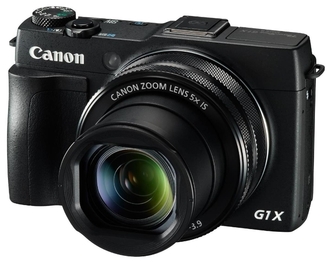 9.5 / 10
Rating
Reviews
I am glad that I managed to buy a Canon PowerShot G1 X Mark II camera at the old prices - the camera is very good, but now it is unreasonably expensive. |
Best mirrorless Canon with interchangeable optics
|
186 000
Undoubtedly, lately this camera has become the most discussed novelty from Canon. Both Japanese “titans”, by the way, for a long time ignored this market segment, offering system mirrorless only in crop formats, but finally offered a “full frame”.It seems, and they still realized that Sony is already actively picks up this segment for themselves. Canon's mirrorless fullframe received a new bayonet, but, fortunately, the company provided an opportunity to use existing EF lenses through an adapter - given that the range of “relatives” is still small, and the target audience often already has a “Canon” SLR camera, this possibility will not be superfluous. Formally, the camera looks like an EOS 5D Mark IV, devoid of a mirror - similar “dual pixel” sensors, average burst speed, support for 4K video. But there is a lot of difference in the “stuffing” - for example, the DIGIC 8 processor is used. With the new lenses (by the way, interesting by themselves), the focus works very fast, which, combined with the moderate size and weight of the camera, calls itself outside - the camera is definitely ready for high-speed shooting on the go. However, the camera “mates” normally with optics under the EF mount. And the ability to quickly change the focus point with touchscreen touchscreens, without looking up from the viewfinder, further simplifies high-speed shooting. An interesting feature of the camera is that the shutter is closed when it is turned off, unlike other mirrorless ones. That is, when replacing optics with a matrix, dust will not fall: this is even a larger application for professional use than the characteristics of the matrix or the quality of optics. Imagine yourself what it is like to shoot optics in dust or under drizzling rain when the sensor is open. However, the camera did not get rid, alas, of the main problem of mirrorless - its autonomy is significantly inferior to the SLR with a similar battery capacity, which is not surprising. So, if the same 5D allows you to walk for a long time without spare batteries, then with EOS R you will begin to think about the battery grip. Main advantages:
Minuses:
|
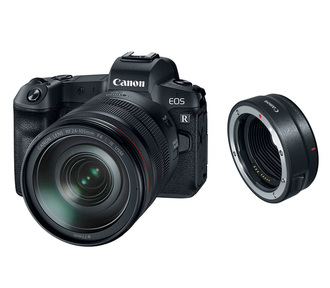 9.9 / 10
Rating
Reviews
The camera is curious, with good capabilities, but, of course, the price makes you wonder if you need it if you already have a mirror full frame. |
|
49 990
Bezzerkalka at a price comparable to a good for the amateur "SLR" with a whale? Yes, it also happens. And the filling of this Canon camera is quite consistent with the price: the flagship of the EOS M series, released at the end of 2016, hit the spot, becoming a full-fledged tool for a professional photographer who is looking for an easy and fast camera in addition to a heavy DSLR.
Canon EF-M bayonet is also designed for this. It allows you to easily put any EF lens from your stock on the "carcass" through the adapter (although the M5’s whale optics is not bad - f2.0 is rare for the same price for whale optics), and APS-C matrix with 24 million effective pixels, giving a juicy picture with excellent detail and low noise. The use of Dual Pixel technology for autofocus made the camera very brisk, which should be noted. In contrast to the “younger” EOS M, a full-fledged viewfinder appeared here, but it is easy to crop by touchscreen even in the bright sun, and the support for controlling the zoom and sharpness with the usual gestures of two fingers is just what we need. The stabilization system works great in both photo and video mode: in fact, in many cases this camera will be more convenient than a DSLR, without forcing to sacrifice the functionality and quality of photos. Main advantages:
Minuses:
|
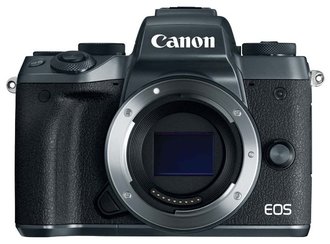 9.8 / 10
Rating
Reviews
Gorgeous "walking" camera - when you get a good shot, you can do it instantly, not dragging extra weight. |
Canon's best ultrazoom
|
28 490
Very nice and modern in terms of filling the camera Canon, equipped with optics with a forty-fold zoom, will make it possible to take more than one successful photo, without taking away extra space in your pocket or luggage. Yes, of course, the 1 / 2.3 matrix is not even APS-C, but, at least, for the sake of marketing, they didn’t inflate megapixels, limiting themselves to a reasonable figure of 20.3 megapixels. The DIGIC 8 processor is responsible for image processing, the same as in the flagship full-frame “mirrorless” EOS R. The camera is equipped with a five-axis digital stabilization (the lens also has a moving lens group, so the stabilizer is not “purely digital”) and can shoot 4K- video - well, what is not a universal option for those who need a compact “digital camera”? Burst speed - 10 frames per second, if you use autofocus on the first frame. With constant autofocus, it drops to 7.4 fps, but this, you see, is an excellent indicator. As befits a modern "compact", the camera received a flip screen for video lovers and "sashchashek." Even inside the compact case they managed to hide a more or less sane flash. And, of course, do not forget the support of Wi-Fi and NFC. However, one should not forget that the compact camera is compact. The high density of pixels on the matrix inevitably limits the working range of the ISO, in the shadows noises begin to creep out quickly. Even a “cadre” level a reflex camera with whale optics from a four-digit series will give the best image quality for the same money, you can’t get away from it - but it will not have a range of equivalent focal lengths of 24-960 mm and sizes ... Main advantages:
Minuses:
|
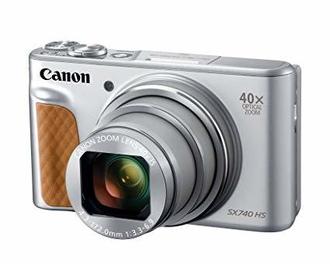 9.8 / 10
Rating
|
Best Canon Amateur SLR Cameras
|
25 990
“Update without updates” - perhaps, this is the way to name the latest of four-digit series cameras that have come out at this moment. Indeed, we have already seen all the hardware gathered in it on Canon cameras of the lower segment, and still the feeling of the utmost depreciation spoils all communication with the camera. Of course, a metal bayonet finally appeared here, and a diopter corrector returned to the optical viewfinder, but it is difficult to call it a merit - after all, these are the things that are in the mirror camera themselves. The 24-megapixel sensor is not bad, if you do not get involved in high ISO values - as befits an extremely budgetary “crochet”, noise starts to appear quickly, and at the maximum sensitivity level, the picture will satisfy only when it is reduced to meager resolutions, the detailing deteriorates very much. From the point of view of ergonomics, of course, the Canon 2000D camera is much better in comparison with what we have seen in the “four-digit” series: for one switch installed on the mode selector that was used here earlier, the creators should be beaten with a tripod . 2000D, at least, already looks like a normal "SLR". Main advantages:
Minuses:
|
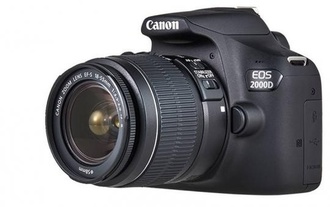 9.4 / 10
Rating
|
The best Canon cameras "advanced amateur" class
|
44 990
Canon's new product brought another prestigious award to the company - this time in the nomination Consumer DSLR Camera 2017-2018 by EISA, the European Association of magazines for AV-technology. This is not surprising, because when developing a new model, solutions previously tested on a semi-professional EOS 80D were used. The 24.2-megapixel APS-C matrix with Dual Pixel technology not only provides a high-quality picture, but also provides ample autofocus, and the Digic 7 processor allows you to use this “SLR” for shooting FullHD video at 60 fps. If you compare with the semi-professional “source”, then the cheapening didn’t spoil the camera much - yes, the viewfinder coverage decreased from 100% to 95%, the moisture protection was removed, the range of shutter speeds reduced ... But for amateur photographers who use this camera, such things will not become critical, Here's the combination of price and functionality allows Expert Price to join EISA: we really have the best entry-level SLR camera that you can buy in our stores. Main advantages:
Minuses:
|
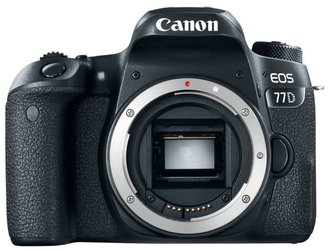 9.8 / 10
Rating
Reviews
Now you can compare with a professional camera - you know, in my opinion, the 77th looks pretty good against such a background, and the price gap is one hundred thousand! |
|
49 990
For the money, which will cost the "eight hundredth" whale, this Canon camera is undoubtedly very interesting. The proven “choking” scheme of semi-professional cameras when creating advanced models for ordinary photographers in this particular case gives us a “dual pixel” matrix with good detail and high ISO, and 45 focus points instead of the obviously insufficient nine, which were previously used on most amateur cameras, but on the “caddy” remained until now. The author, thoroughly hooked on the manual optics, can not fail to note how much it has facilitated the use of the camera, even with manual focus with confirmation. With a “rate of fire” of 6 fps, the camera is limited in the number of frames only if you use RAW — in JPEG, the buffer may not overflow at all if the installed SD card can withstand the desired recording speed. A good application for “reportage” - let the shooting speed of professional cameras be twice as high, the price for a carcass is almost ten times higher! If videobloggers bit you in a dark corner of the Barbershop, then we note that the camera was prepared perfectly for shooting video: let it not write 4K, but it has excellent FullHD quality, besides with very fast focusing due to “dual pixel”, and the stock of these very pixels allows for high-quality digital stabilization. True, like the other "Kanonov", here are still limited to the maximum recording duration and file size. And this is with the support of exFAT, where the physical limitation of 4GB has not been relevant for a long time! Main advantages:
Minuses:
|
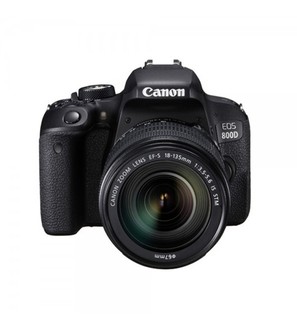 9.7 / 10
Rating
Reviews
The camera that I bought for a long time, seriously, is a very high level for the XXXD series. Another would be an alternative firmware ... |
Canon best semi-professional SLR cameras
|
37 138
An excellent fullframe, which can be put on the budget in the price of a whale class lower, if you take the optics on the secondary market, especially if you do not limit yourself to only original Canon lenses.In addition to the quality of the sensor, the camera and excellent autonomy - finally, Canon allows you to take more than a thousand shots on one battery, without having to buy a spare or battery grip. Those, of course, also have their advantages in the form of convenience of vertical shooting, but the dimensions of the camera grow decently. The rotary touch screen in combination with the matrix Dual Pixel fully reveals its capabilities: unlike the old DSLRs, which in Live View mode could focus only on contrast (and this is too slow, whatever one may say), the "six" of the second generation allows you to simply poke the right place of the screen with your finger so that the camera puts the focus and takes a picture. "Smartphone" ease of management with full image quality, which gives a full frame with interchangeable optics - yes, whatever one may say, but in the courtyard is the 21st century, and in uncomfortable positions, the camera can shoot quickly and accurately. Well, retrogrades that use only the optical viewfinder will appreciate the presence of 45 focus points, although they will complain that they are noticeably crowded to the center - sometimes you have to use autofocus fixation when shooting frames with a complex composition. The only thing worth regretting is that Canon has deprived the camera of the magnesium case for the sake of cheaper prices, hinting once more that the camera is professional only with the prefix “floor”. Main advantages:
Minuses:
|
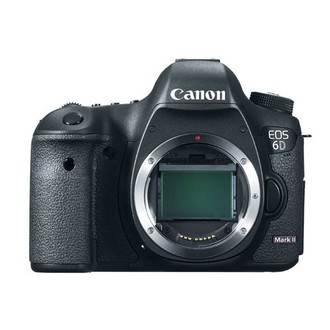 9.9 / 10
Rating
Reviews
If you immediately take the optics of the L-series here, then it will be possible to “grow out” of this camera for a very long time. |
|
87 694
In its class, this is, if not the best, then one of the most popular models. She was appreciated by numerous photographers around the world. The creators literally squeezed all the juice from the sprinkled matrix. Without any problems, you can shoot at almost any ISO value. In the serial mode, 10 frames per second are created, which allows using this model as a reporting camera. Everything is in order here and with video filming - the picture is written in Full HD with a frequency of 60 frames / s. And even the lack of Wi-Fi does not look like a disadvantage, because any professional will first process the images on the computer. And for remote control, you can use a special remote. Main advantages:
Minuses:
|
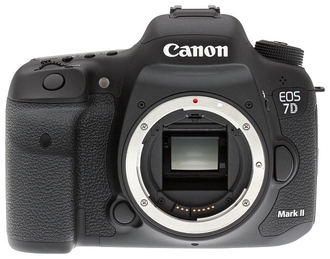 9.4 / 10
Rating
|
Top Canon Professional SLRs
|
305 590
Top professional camera, recognized as the best in Europe in 2016-2017, according to EISA. Already at the first meeting, the camera amazes with Leviathan scale and size, and prices - and note that there are no whale versions on sale for obvious reasons, you will give all 300,000 for only the "carcass". We will not talk about the possibilities of this camera for a simple reason: the author, with all the desire, cannot consider himself able to judge the technique of this level. But the fact that, in the opinion of true professionals, the EOS 1D X Mark II is capable of making a good shot in any situation, easily moving from a machine-gun queue of 14 frames per second of continuous shooting to 4K video mode (at 60 frames per second!) Undoubtedly makes to bow to the creators. Main advantages:
Minuses:
|
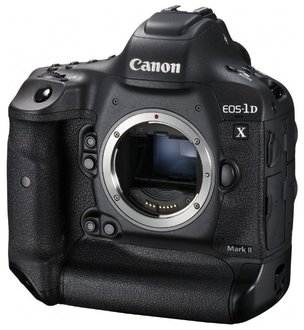 10 / 10
Rating
Reviews
Undoubtedly, the top-level camera. It is a pity that not just any report you take - almost one and a half kilograms without a set of lenses. |
|
171 370
The absolute champion in this year's awards, who received awards from the professional segment of SLR cameras both in TIPA version and EISA version. However, even before that, 5D of all generations was one of the most popular tools of professional photographers, so the current fourth incarnation flagship continues the tradition of the Canon family: after all, it was EOS 5D that first came into the world of digital photography with a full-frame matrix, and then proved that "SLRs" can shoot video. In the new generation, the matrix of 30 million effective pixels received Dual Pixel technology, and it is used not only for autofocus operation: every half-pixel is also registered in RAW, which greatly expanded the possibilities of image processing. There are two Digic 6+ and Digic 6 processors in the camera: one processes the signal from the matrix, while the second is occupied by metering at 150 thousand points. Moreover, in the burst mode, the tracking autofocus and metering continue to work, and the concept of buffer size when working in JPEG just lost its meaning: the camera can continuously write “series” until the memory card is full. If the EOS 5D Mark II was the first “SLR” capable of shooting video in general, the “Fourth Mark” is already boasting about shooting 4K video. However, keep in mind that it simply cannot work in this mode with SD cards: their speed is not enough, so you will need a CF card at 100 MB / s. Main advantages:
Minuses:
|
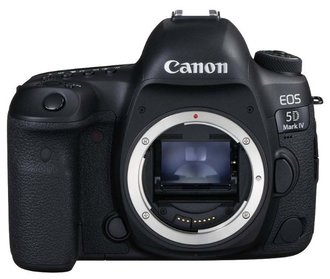 9.9 / 10
Rating
Reviews
I do not know which camera can argue with this: it’s not for nothing that the 5D family can already be considered a legend. |
In the Canon model lineup, contradictory trends continue to be observed, which is confirmed by the statistics of prestigious awards: while remaining a recognized leader in the field of professional mirror technology, the company is also shifting towards the budget segment - an example of this not only the IXUS series, but also the entry into the market of extremely cheap mirror EOS 1200D. The development of professional mirrorless cameras is also pleasing - now the photographer can afford to walk with a compact camera, while retaining the ability to use all the optics from his main mirror Canon. So, even taking into account the serious offensive by Sony and Fujifilm on the market (the last in 2019 "snatched" 2 TIPA awards, 5 EISA awards from Sony), Canon and Nikon remain real heavyweights.
But with the cameras for outdoor activities, “Canon” seems to be forgiven: in the current model range there is only one model D30, which is very poorly represented in the sale. Therefore, we did not even include this category in the rating.

